Overview
The article “Mastering HL7 Integration: Best Practices for Proven Success” highlights the imperative need for effective strategies and practices in achieving successful HL7 integration within healthcare systems. Mastering HL7 integration is not just beneficial; it is essential for enhancing interoperability and improving patient care. Evidence supports the assertion that effective integration significantly reduces errors and boosts operational efficiency in medical organizations.
Have you considered the impact that seamless integration can have on your organization? By adopting best practices in HL7 integration, healthcare providers can streamline processes and enhance the quality of care delivered to patients. Furthermore, the integration of HL7 standards fosters collaboration across various systems, paving the way for a more interconnected healthcare environment.
As a result, organizations that prioritize HL7 integration can expect to see tangible improvements in both patient outcomes and operational metrics. The call to action is clear: embrace HL7 integration to not only meet industry standards but to excel in delivering exceptional patient care. Take the first step towards mastering HL7 integration today.
Introduction
In the rapidly evolving landscape of healthcare, the integration of diverse systems is not merely a technical challenge; it is a vital necessity for improving patient care and operational efficiency. HL7 (Health Level Seven) integration stands at the forefront of this transformation, enabling seamless communication between disparate healthcare applications and ensuring that critical patient information is exchanged accurately and promptly.
As organizations strive for interoperability, understanding the intricacies of HL7 standards becomes paramount. This article delves into the essential components of HL7 integration, the significance of modern technologies like FHIR, and best practices for overcoming common challenges.
With real-world success stories illuminating the path forward, the importance of mastering HL7 integration in today’s interconnected healthcare environment cannot be overstated.
Understanding HL7 Integration: A Comprehensive Overview
HL7 (Health Level Seven) linking is a crucial process that connects various medical systems and applications, facilitating the seamless exchange of both clinical and administrative data. This unification is essential for achieving interoperability among disparate systems, enabling healthcare providers to share patient information efficiently and effectively.
At the heart of HL7 connectivity lies the understanding of HL7 message structures, composed of various segments and fields. Mastering these components is vital for organizations striving to implement HL7 standards successfully. By ensuring accurate information flow between systems, organizations can uphold the integrity and security of sensitive patient details.
Recent developments in HL7 integration underscore its growing significance in the medical field. As of 2021, the percentage of hospitals participating in national and state, regional, or local networks increased from 53% to 64%, reflecting a notable shift towards standardized data exchange practices. This trend emphasizes the increasing reliance on HL7 integration to enhance communication and collaboration among medical entities.
Expert opinions further highlight the importance of HL7 integration in contemporary medical practice. For instance, a study found that effective coordination could reduce patient journey times by over 14 minutes and improve the speed of patient identification by 10 minutes. Adi A AlQudah from the Faculty of Engineering & IT remarked, “The proposed solution is efficient and could reduce the ‘patient’s journey time’ by more than 14 minutes and ‘time to identify’ patients by 10 minutes.”
These improvements not only enhance patient experiences but also streamline operational workflows within medical organizations. Furthermore, Avato’s hybrid unification platform ensures 24/7 availability for essential connections and provides real-time tracking and notifications on system performance, underscoring the importance of reliability in HL7 unification, particularly in sectors like banking, medical services, and government.
The role of HL7 messages in medical system coordination is paramount. These messages act as the backbone for data exchange, guaranteeing that critical information is communicated accurately and promptly. Successful examples of HL7 integration can be seen in various medical systems that have adopted these standards to boost interoperability and patient care.
Case studies examining the challenges and benefits of FHIR (Fast Interoperability Resources) illustrate the evolving landscape of medical integration. While FHIR presents technical complexities and privacy concerns, its potential for real-time access to patient information and enhanced interoperability is undeniable. As FHIR continues to integrate with AI and broaden its applications, it is poised to drive more standardized global adoption of HL7 integration, further enhancing the capabilities of medical systems.
In summary, mastering HL7 connectivity is essential for medical organizations aiming to improve data exchange, elevate patient care, and maintain a competitive edge in an increasingly interconnected environment. Avato’s dedicated hybrid unification platform plays a critical role in simplifying complex connections, maximizing the value of legacy systems, ensuring the reliability necessary for effective medical operations, and significantly reducing costs associated with unification efforts.
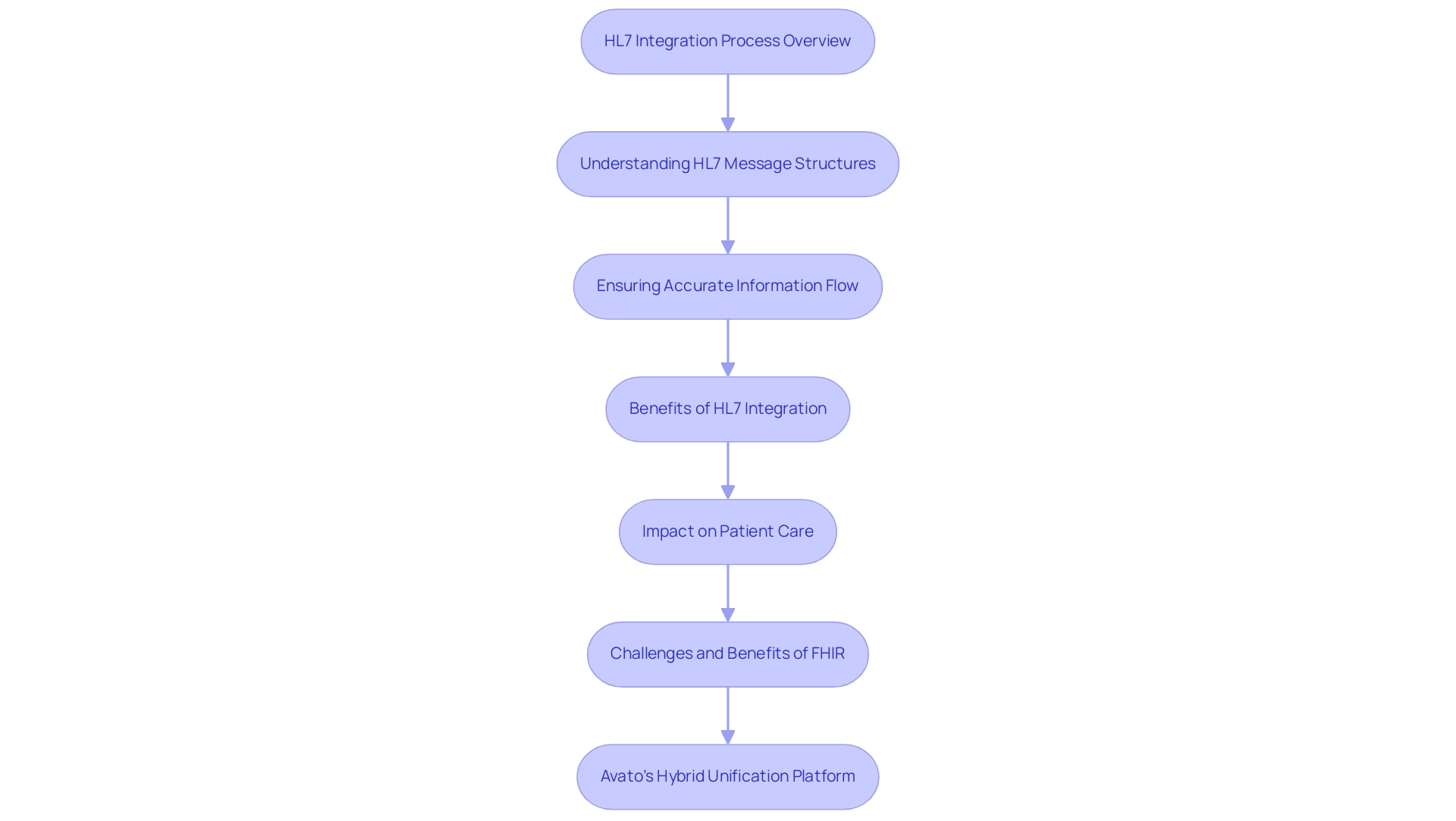
The Significance of HL7 Standards in Healthcare Communication
HL7 integration is pivotal in medical communication, establishing a robust framework for the exchange, sharing, and retrieval of electronic health information. By standardizing information formatting and transmission, HL7 integration significantly enhances interoperability among various medical systems, which is essential for coordinated patient care. However, HL7 V2 has faced criticism for its ambiguity and excessive flexibility, resulting in inconsistencies and overlaps.
This underscores the critical nature of HL7 integration, especially with HL7 V3 and the Reference Information Model (RIM), which are vital for advancing integrated clinical systems. As Russler points out, these standards lay the groundwork for the subsequent standards necessary for electronic health records (EHRs), supporting concept-oriented terminologies and automated clinical guidelines that improve interoperability and the organization of clinical information. The adoption of HL7 integration has been shown to enhance information accuracy, reduce errors, and bolster patient safety, ultimately leading to improved medical outcomes.
For instance, organizations that have embraced HL7 integration report a notable increase in the efficiency of data exchange, with studies indicating that effective communication can cut patient wait times by up to 30%. Case studies further illustrate the positive impact of HL7 integration on patient care; hospitals that have implemented HL7 integration have documented a 20% reduction in medication errors. By ensuring seamless communication through HL7 integration, organizations can provide timely access to critical patient information, fostering a more effective medical delivery system.
Avato’s hybrid unification platform is specifically designed to tackle the challenges of connecting isolated legacy systems, offering a dedicated solution that mitigates risks associated with digital transformation. With features such as 24/7 uptime, secure transactions, and support for 12 levels of interface maturity, Avato combines speed, security, and simplicity. As Tony Leblanc from the Provincial Health Services Authority states, ‘Good team. Good people to work with. Extremely professional. Extremely knowledgeable.’
This positions Avato as a leader in the unification market, enabling medical organizations to effectively leverage HL7 integration and enhance their operational capabilities.
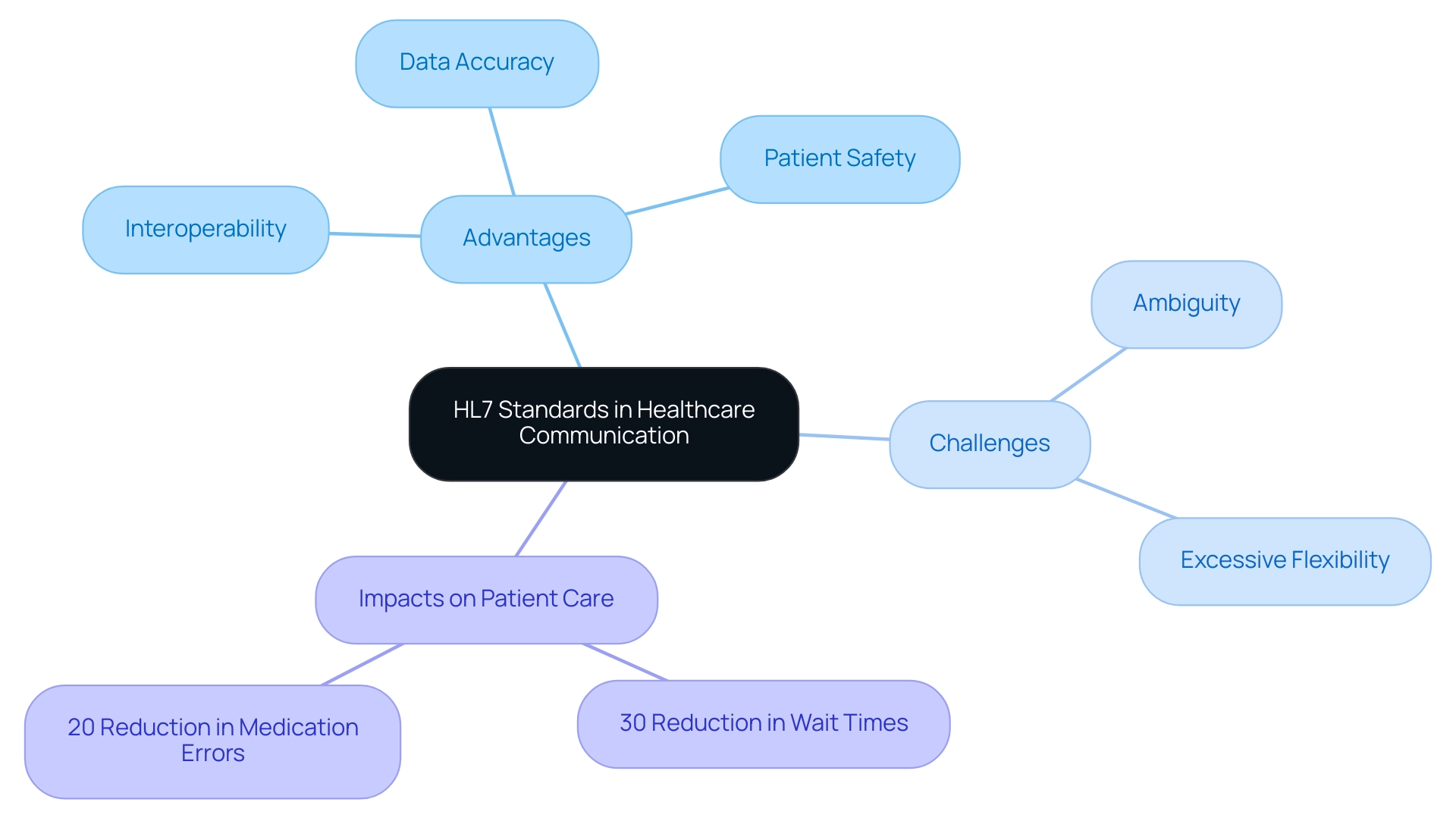
Navigating the Challenges of HL7 Integration
HL7 connectivity presents a variety of challenges that organizations must manage to ensure effective information exchange and interoperability. One of the most pressing issues is mapping discrepancies, which can occur frequently in healthcare integrations. Studies indicate that up to 30% of information mappings can contain errors, leading to significant miscommunication and potential errors in patient care.
A simulation experiment involving 517 valid appointments further underscores the prevalence of these discrepancies, highlighting the critical need for accurate data mapping. Furthermore, organizations frequently encounter compatibility challenges between HL7 standards and current legacy systems, complicating the merging process and necessitating significant resources and expertise.
The complexity of legacy systems adds another layer of difficulty. Numerous healthcare organizations depend on obsolete technologies that are not intended to function smoothly with contemporary connection solutions. This can lead to extended timelines for combining efforts and higher expenses.
To effectively address these challenges, organizations should undertake comprehensive assessments of their current IT infrastructure. This evaluation will help identify specific collaboration pain points and prioritize efforts based on strategic objectives.
Investing in staff training is crucial for a successful transition. Ensuring that team members are well-versed in HL7 standards and best practices for combining systems can significantly reduce the likelihood of errors and enhance overall project efficiency. Entities that emphasize training and development observe a significant enhancement in their assimilation results, especially when utilizing Avato’s hybrid connection platform, which is crafted to simplify intricate linkages and improve information connectivity.
Avato’s commitment to addressing intricate integration challenges is clear in its focus on delivering effective solutions that empower organizations. In addition, employing a systematic method to HL7 integration can improve interoperability and enhance information accuracy. Key components such as information standardization, messaging frameworks, and security protocols must be meticulously implemented to ensure compliance with healthcare regulations.
Utilizing XSLT within Avato’s platform can further streamline XML transformation, reducing programming errors and related costs. Additionally, the use of schemas in data management can lead to significant cost savings by preventing errors and ensuring data integrity. As Alexandr Pihtovnicov, Delivery Director at TechMagic, observes, ‘HL7 incorporation enhances medical interoperability but presents considerable challenges.’
By concentrating on these components, organizations can surmount typical obstacles related to HL7 integration and prepare themselves for success in the changing medical environment. Furthermore, future research can build on existing studies to address gaps in healthcare information technology incorporation, further enhancing the effectiveness of HL7 solutions.
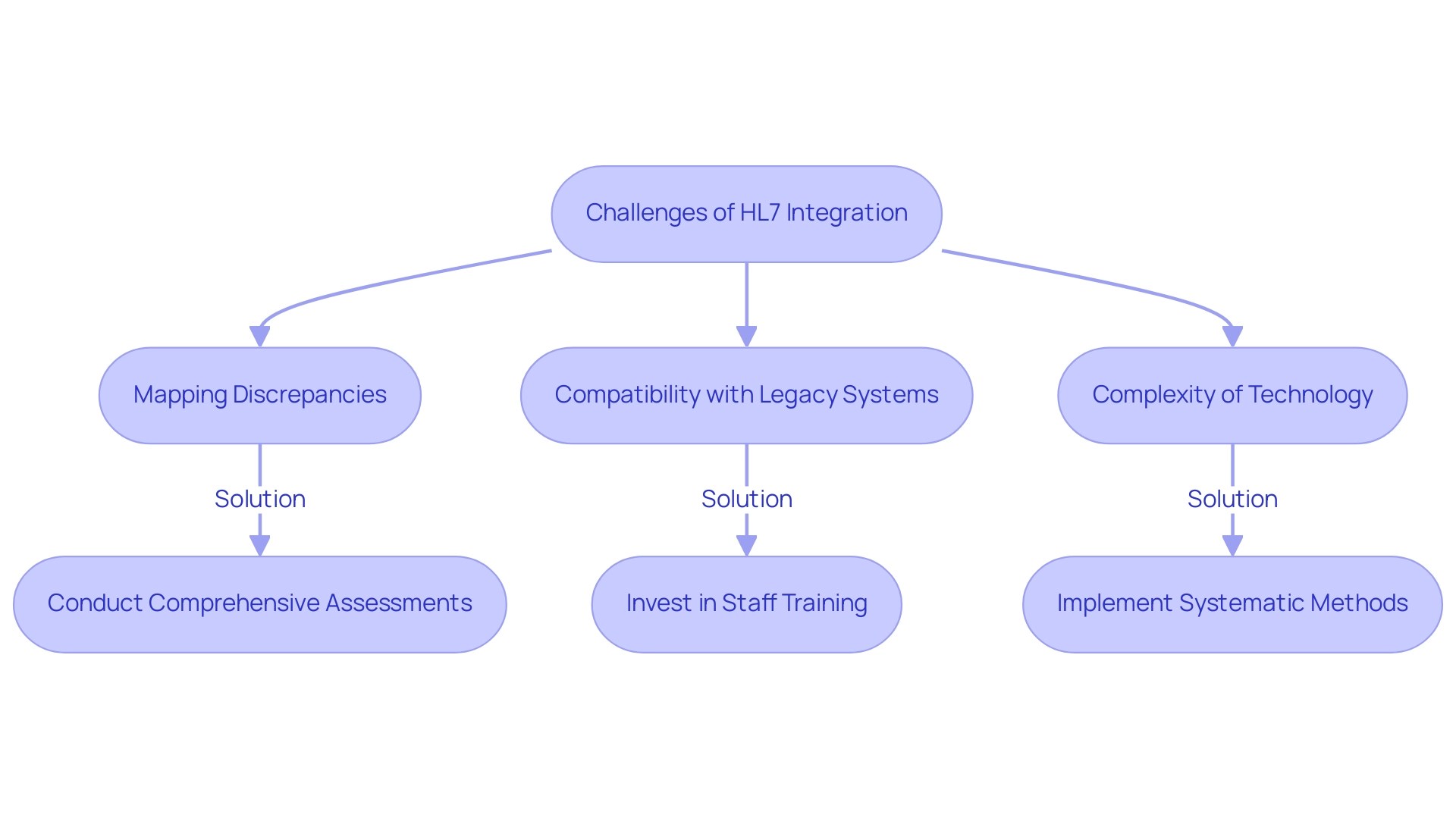
Approaches to HL7 Integration: Point-to-Point vs. Interface Engines
In the realm of HL7 connectivity, organizations encounter two primary approaches: point-to-point connections and interface engines. While point-to-point linking establishes direct connections between each pair of systems, which may appear straightforward for small-scale implementations, it quickly becomes intricate and cumbersome as the number of systems grows. This complexity can lead to substantial maintenance difficulties and potential connection failures.
Conversely, interface engines serve as intermediaries that facilitate communication among various systems, offering a more scalable and flexible connection solution. These engines excel in managing data transformation, routing, and protocol conversion, all essential for ensuring seamless interoperability in medical environments. By centralizing connection processes, interface engines significantly alleviate the maintenance overhead associated with numerous point-to-point connections.
The advantages of utilizing interface engines for HL7 integration become particularly clear in complex healthcare environments. A recent study highlighted a median difference of 14:11 minutes in patients’ journeys when effective coordination solutions were employed, underscoring the impact of streamlined data flow on operational efficiency. This statistic illustrates how Avato’s reliable, future-ready hybrid connection platform, equipped with features such as real-time monitoring and alerts, can enhance connection processes, ultimately improving patient care and maximizing the value of legacy systems.
Moreover, industry experts advocate for interface engines as a best practice, citing their capacity to adapt to evolving healthcare demands while upholding robust security and compliance standards. Gustavo Estrada, a client from BC Provincial Health Services Authority, remarked, “Avato has streamlined intricate projects and provided outcomes within expected timelines and budget limitations,” emphasizing the efficacy of interface engines in achieving successful HL7 integration.
Case studies reveal that organizations utilizing interface engines, such as those represented by John Johnstone from OSME Pacific and Gustavo Estrada, have adeptly navigated the challenges of HL7 integration, achieving faster deployment times and enhanced data accuracy. This trend is increasingly pertinent as medical systems strive to modernize and improve patient care through technology. As the landscape of HL7 connectivity continues to evolve, the preference for interface engines over traditional point-to-point methods is becoming increasingly evident, establishing them as the cornerstone of effective healthcare connectivity strategies, particularly with Avato’s hybrid solutions.
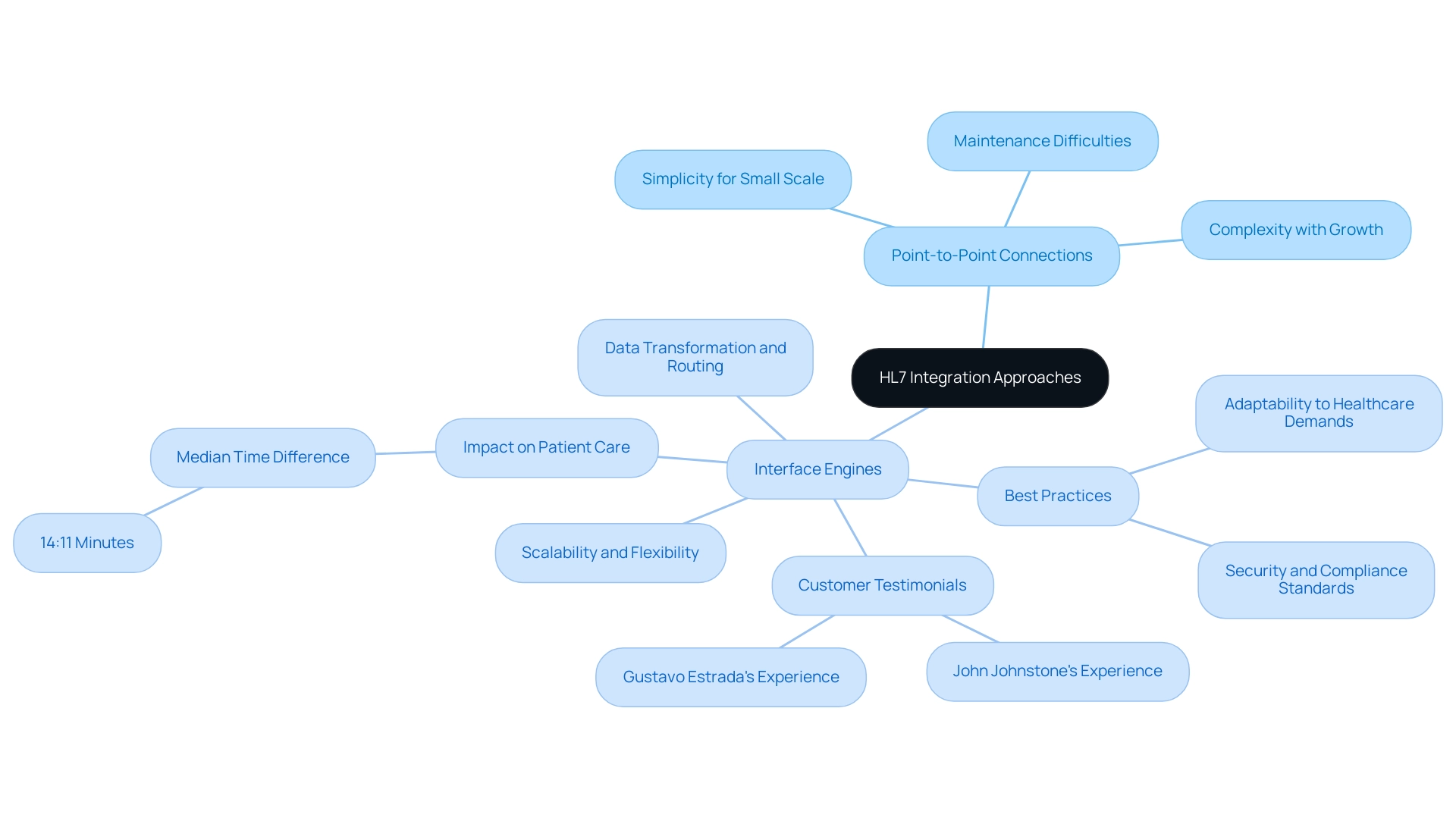
Best Practices for Successful HL7 Integration Implementation
To achieve successful HL7 integration, organizations must adhere to several best practices that significantly enhance efficiency and effectiveness:
-
Conduct a Comprehensive Assessment: Begin with a thorough evaluation of existing systems and information flows to pinpoint connection points. This foundational step ensures that all relevant systems are considered, facilitating a smoother integration process.
-
Develop a Clear Information Mapping Strategy: Establish a detailed mapping strategy that outlines how information will be translated between systems. Leveraging XSLT in this process can significantly streamline transformation tasks, reducing labor and minimizing programming errors. This clarity is crucial for maintaining information integrity and ensuring that all stakeholders understand the flow of information.
-
Engage Stakeholders Early: Involve stakeholders from various departments at the outset to gather requirements and ensure alignment across the organization. Effective stakeholder engagement has been shown to enhance project outcomes significantly, with evidence indicating that organizations with strong stakeholder involvement experience a marked increase in project success rates.
-
Implement Robust Testing Protocols: Prior to going live, it is essential to implement rigorous testing protocols to validate data integrity and system performance. Employing schemas alongside XSLT can identify errors during the coding phase, further reducing risks and ensuring that the system operates as intended, ultimately improving patient care and operational efficiency.
-
Establish a Monitoring Framework: After implementation, set up a monitoring framework to track performance continuously. This proactive approach allows organizations to quickly identify and address any issues that may arise, ensuring sustained operational effectiveness.
By adhering to these best practices, organizations can significantly improve their prospects of achieving seamless HL7 integration. For instance, the incorporation of HL7 in Laboratory Information Systems (LIS) has demonstrated real-time data exchange capabilities, reducing errors and improving patient care through timely access to test results. This unification has been shown to enhance patient identification time and overall journey time, highlighting the effectiveness of HL7 in boosting operational efficiency.
Furthermore, a statistic indicating that 48.36% of treatment stages met their targets during intervention weeks underscores the quantitative benefits of HL7 incorporation. As Alexandr Pihtovnicov, Delivery Director at TechMagic, states, “HL7 integration is a strategic move to enhance patient care, interoperability, and operational efficiency.” Such successful implementations emphasize the importance of a strategic approach to HL7 integration, as highlighted by industry experts who advocate for these methodologies as essential for enhancing interoperability and operational efficiency.
Additionally, the HL7 engine approach serves as middleware to connect multiple systems and transform data formats, removing the need for various interfaces, which further enhances the connection process. Avato’s dedicated hybrid unification platform plays a crucial role in this landscape, simplifying the connection of disparate systems and enhancing overall business value. By utilizing Avato’s platform, organizations can achieve significant cost savings and minimize errors, ensuring a more efficient implementation process.
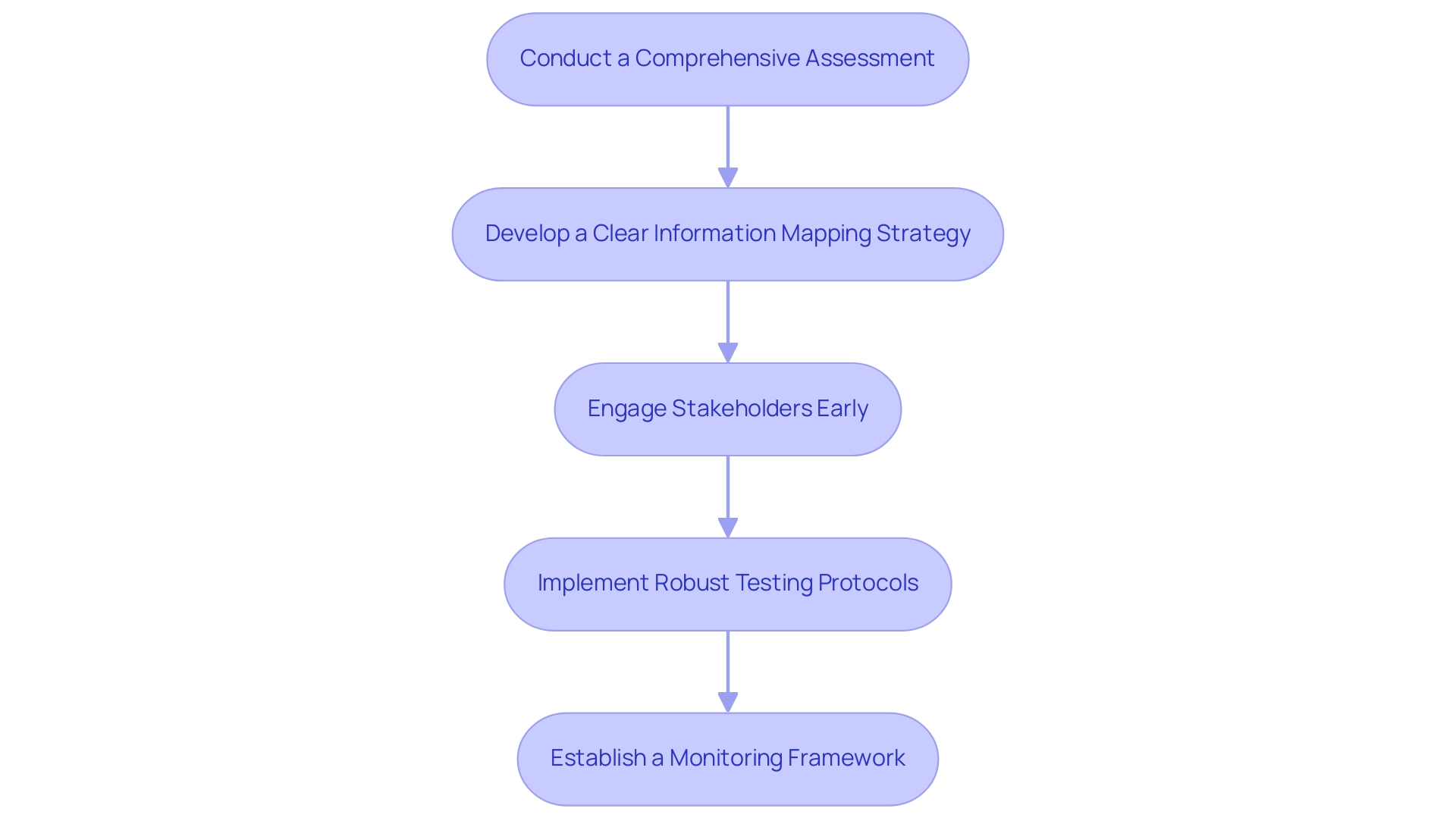
Leveraging Modern Technologies for Enhanced HL7 Integration
Modern technologies, particularly FHIR (Fast Healthcare Interoperability Resources) and cloud-based solutions, are revolutionizing HL7 integration in 2025. FHIR employs RESTful APIs to facilitate information exchange, allowing medical organizations to link previously isolated systems with increased speed and efficiency. This shift is crucial as it aligns with the growing demand for interoperability, with predictions indicating that by 2025, 90% of health systems globally will adopt FHIR APIs, driven by regulatory mandates and the need for improved healthcare data access. This statistic highlights the urgency for organizations to adopt FHIR in their incorporation strategies.
Cloud solutions further enhance this connectivity landscape by providing scalability and flexibility, allowing organizations to adjust their strategies in response to evolving needs. The advantages of cloud-based solutions for HL7 integration are considerable; they not only lower expenses but also enhance operational capabilities, allowing providers to deliver superior patient care.
As medical providers increasingly recognize the importance of FHIR in facilitating seamless data exchange, expert insights highlight the necessity for proper training and knowledge among IT professionals and administrators. A collective effort from governments, healthcare organizations, and technology providers is essential to fully realize the potential of a connected healthcare future. Gustavo Estrada remarked, “Avato has the capability to simplify intricate projects and deliver outcomes within preferred timeframes and budget limitations,” underscoring the importance of efficient solutions in attaining these objectives.
Avato accelerates the unification of isolated systems and fragmented data, delivering the connected foundation enterprises need to simplify, standardize, and modernize. Designed for secure transactions, Avato is relied upon by banks, the medical sector, and government. It is tailored for collaborative projects where 24/7 uptime is essential, with no allowance for defects, errors, or outages, providing a sturdy foundation for your digital transformation initiatives.
Success narratives from early users demonstrate how FHIR incorporation has resulted in enhanced patient outcomes and streamlined service delivery, despite obstacles such as implementation expenses and knowledge deficiencies. For instance, the case study titled “Future of FHIR Adoption” suggests that the extensive use of FHIR is poised to transform medical interoperability, facilitating enhanced information exchange and improving patient outcomes.
Furthermore, the creation of an intuitive graphical user interface has enabled end-users to access and examine information effectively, showcasing the practical aspects of applying FHIR and cloud solutions in HL7 connectivity.
In summary, the combination of FHIR and cloud solutions is not merely a trend but a crucial movement towards achieving effective HL7 integration, ultimately improving information accessibility and patient care across the healthcare sector. Avato’s dedicated hybrid unification platform, which supports 12 levels of interface maturity, plays a crucial role in simplifying disparate systems and enhancing business value, empowering organizations to future-proof their operations through seamless information and system unification.
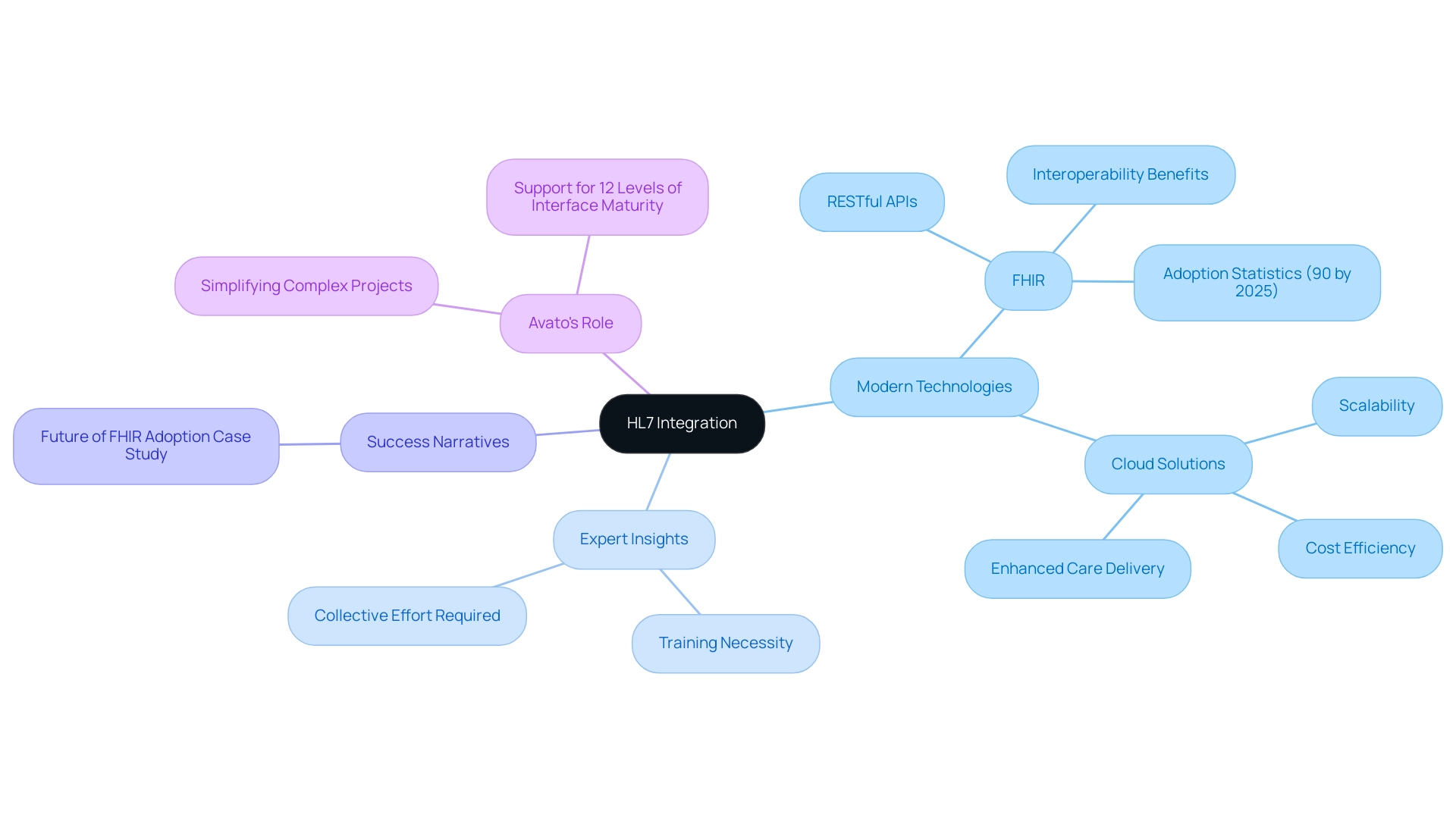
The Role of Real-Time Monitoring in HL7 Integration Success
Real-time monitoring is essential for the success of HL7 integration, offering critical insights into system performance and information flows. Organizations must adopt monitoring tools that can track message delivery, data integrity, and overall system health in real-time. This proactive strategy empowers teams to quickly identify and resolve issues before they escalate, ensuring that connections remain operational and effective.
Avato’s dedicated hybrid connectivity platform plays a pivotal role in this process, streamlining the unification of disparate systems and enhancing business value. By leveraging Avato’s expertise, organizations can future-proof their operations through seamless data and system integration, which is increasingly vital as the healthcare landscape evolves. Projections suggest that by 2030, 80-90% of outpatient visits will be virtualized, making robust monitoring tools even more crucial.
Establishing performance metrics and alerts is critical for maintaining high service standards and ensuring compliance with regulatory requirements. These tools not only enhance operational efficiency but also facilitate the incorporation of advanced technologies, such as AI in remote patient monitoring (RPM) solutions, which is anticipated to be adopted by 40% of practices.
Success stories abound in the realm of HL7 integration, where organizations have effectively utilized monitoring tools to achieve significant improvements. For instance, one client stated, “Avato’s hybrid integration platform revolutionized our information management processes, enabling us to respond to issues in real-time and maintain compliance effortlessly.” Understanding advanced HL7 topics, including types and the HL7 engine, is essential for ensuring compliance and information integrity.
This knowledge has been instrumental in initiatives like the HL7 Gravity Project, which aims to enhance information exchange in the medical field. By employing effective monitoring tools, organizations can ensure structured and consistent information flow, ultimately expanding HL7’s influence on medical delivery.
As Gustavo Estrada emphasized, Avato simplifies complex projects and delivers results within desired time frames and budget constraints, highlighting the effectiveness of monitoring tools in achieving these objectives. Additionally, the cost-saving benefits of schemas in information management are significant; they prevent costly errors by ensuring integrity from the outset.
Combining FHIR-based EHR data with a CDSS knowledge base ontology can significantly improve interoperability and decision support features, further underscoring the importance of monitoring tools in medical coordination.
In conclusion, the integration of real-time monitoring tools is not merely a best practice; it is a necessity for organizations aiming to navigate the complexities of HL7 integration successfully. The ability to monitor and respond to system performance in real-time is transformative, enabling providers to uphold high standards of care and operational excellence.
![]()
Case Studies: Success Stories in HL7 Integration
Numerous medical organizations have reaped substantial benefits from adopting HL7 integration, resulting in significant improvements in operational efficiency and patient care. For instance, a leading hospital network utilized an interface engine to seamlessly connect its electronic health record (EHR) systems, achieving an impressive 30% reduction in data entry errors. This integration not only improved the accuracy of patient information but also enabled better access across various departments, ultimately enhancing patient outcomes.
In another compelling instance, a medical provider effectively implemented HL7 integration by linking its laboratory information system with its EHR. This initiative streamlined the reporting process and greatly improved communication between clinicians and lab technicians, fostering a more collaborative environment for patient care. Such success stories exemplify the tangible benefits of effective HL7 integration, serving as a blueprint for other organizations aiming to optimize their medical delivery systems.
The enhancements in operational efficiency from HL7 collaboration are underscored by the fact that HL7 integration is supported by over 1,600 corporate members across 50 nations, reflecting a global commitment to advancing medical interoperability. As organizations continue to adopt these standards, the measurable advantages of HL7 integration are likely to increase, creating opportunities for more efficient processes and enhanced patient experiences within the healthcare sector. Moreover, the transition from HL7 V2 to V3 highlights the need for a more structured approach to healthcare information unification, addressing specific use cases more effectively.
Furthermore, contemporary unification practices such as SMART on FHIR provide secure access to EHR data, enriching the overall unification landscape. Gustavo Estrada, a client, noted Avato’s ability to streamline complex projects, aligning with the benefits observed in successful HL7 collaboration initiatives. Tony Leblanc from the Provincial Health Services Authority praised Avato’s professionalism and expertise, further solidifying the company’s credibility.
Avato’s hybrid connection platform is dedicated to accelerating secure system unification across banking, medical services, and government sectors, ensuring that organizations can navigate the complexities of diverse systems while enhancing business value.

Key Takeaways: Mastering HL7 Integration for Future Success
Mastering HL7 connections requires a profound understanding of the standards and effective strategies to navigate the inherent challenges. The key takeaways for success in 2025 highlight the critical role of thorough planning and assessment, which establishes the foundation for effective implementation. Real-time monitoring is essential; it not only enhances system performance but also ensures that medical organizations can respond swiftly to any issues that arise, ultimately improving patient care outcomes.
Statistics underscore the significance of HL7 unification. Faster exchanges of clinical information have been shown to improve treatment outcomes and lower morbidity rates, making it a vital component of modern medical systems. Health Information Exchange (HIE) empowers hospitals to share essential patient information with outpatient clinics and specialists, utilizing HL7 integration to further enhance interoperability and patient care.
Insights from industry experts emphasize that successful HL7 integration is not merely a technical requirement but a strategic necessity for organizations aiming to thrive in the rapidly evolving medical landscape. For instance, Gustavo Estrada highlights Avato’s ability to simplify complex projects and deliver results within desired time frames and budget constraints—crucial for service providers facing tight operational demands. Avato’s Hybrid Integration Platform plays a pivotal role in enhancing these outcomes by facilitating seamless data exchange and interoperability, streamlining digital transformation through structured requirements management.
Moreover, case studies, such as the implementation of a self-check-in solution in medical settings, illustrate the complexities involved in reducing patient wait times. While the solution demonstrated feasibility in minimizing the patient journey, it also underscored the necessity for robust connection technologies like Avato’s to effectively tackle long queues and improve patient experiences.
In summary, mastering HL7 connectivity involves strategic planning, leveraging modern technologies, and adopting best practices that collectively enhance operational capabilities and patient care. By focusing on these areas, healthcare organizations can position themselves for success in an increasingly interconnected environment, with Avato leading the way in hybrid integration solutions for secure and efficient digital transformation. Get your copy now to learn more about how Avato can assist in converting unstructured information into structured requirements, ensuring a streamlined approach to digital transformation.
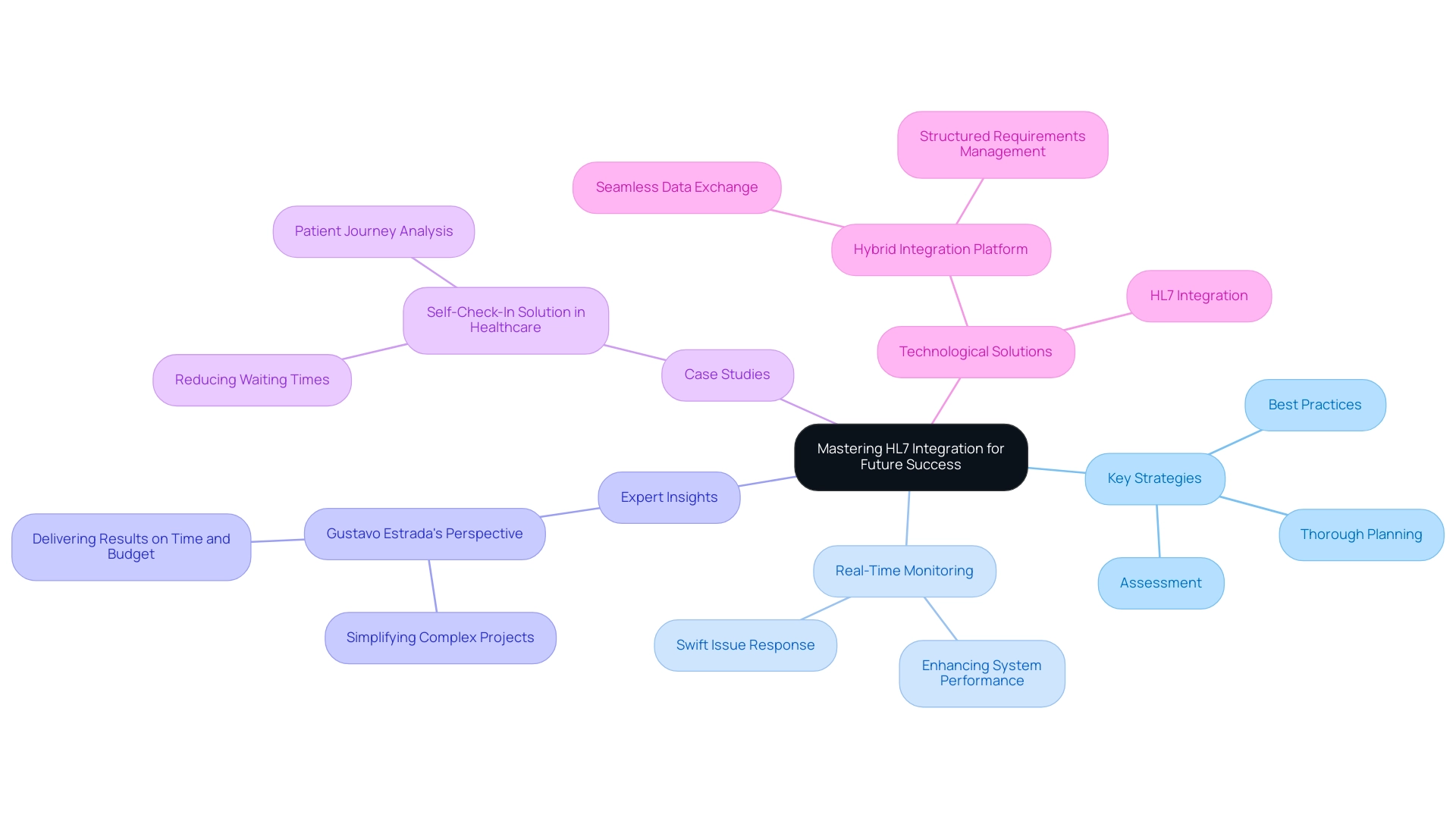
Conclusion
The integration of HL7 standards stands as a cornerstone of modern healthcare, empowering organizations to enhance interoperability and elevate patient care. By grasping the complexities of HL7 integration, healthcare providers can adeptly connect disparate systems, guaranteeing that critical patient information is exchanged with precision and timeliness. This article underscores the essential elements of successful HL7 integration, emphasizing the significance of robust data mapping strategies alongside the necessity for real-time monitoring tools that uphold system performance and data integrity.
Furthermore, the adoption of cutting-edge technologies such as FHIR and cloud solutions is revolutionizing the landscape of healthcare integration, facilitating faster and more efficient data exchange. Numerous case studies illustrate that organizations embracing these technologies have experienced substantial gains in operational efficiency and patient outcomes. The focus on best practices, including thorough assessments and stakeholder engagement, highlights the strategic imperative of mastering HL7 integration in today’s interconnected healthcare environment.
In conclusion, the journey toward effective HL7 integration transcends mere technology; it embodies the cultivation of a culture of collaboration and continuous improvement within healthcare organizations. By leveraging the insights and strategies delineated in this article, healthcare providers can adeptly navigate the challenges of integration, positioning themselves for success in an ever-evolving landscape. The future of healthcare hinges on seamless data exchange and interoperability, and mastering HL7 integration is the key to unlocking these vital capabilities.

